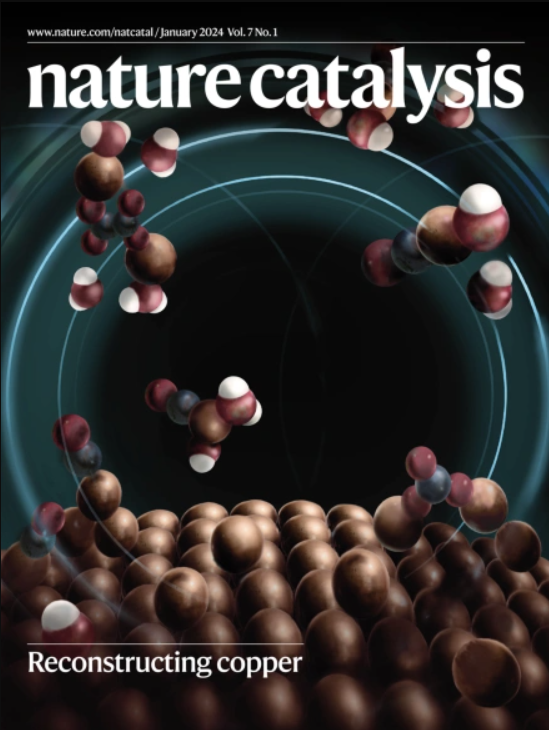Operando probing dynamic migration of copper carbonyl during electrocatalytic CO2 reduction
IF 44.6
1区 化学
Q1 CHEMISTRY, PHYSICAL
引用次数: 0
Abstract
Single crystals and shape-controlled nanocrystals are well known to exhibit facet-dependent catalytic properties. However, few studies have investigated how those nanocrystals evolve and (de)activate during reactions, calling for the development of nanoscale time-resolved operando methods. In this context, we have designed Cu nanocubes as a model system to elucidate the underlying driving force of dynamic nanocatalyst reconstruction during the CO2 reduction reaction (CO2RR). Operando electrochemical liquid-cell scanning transmission electron microscopy (EC-STEM) and synchrotron-based X-ray spectroscopy reveal the size- and potential-dependent complete transformation from (100)-oriented Cu@Cu2O nanocubes to polycrystalline metallic Cu nanograins under CO2RR conditions. In addition, machine learning-assisted operando four-dimensional STEM reveals that large Cu nanograins derived from nanocubes form mainly crystalline domains, while their smaller counterparts are more amorphous due to faster evolution kinetics. In situ Raman spectroscopy and density functional theory calculations suggest that CO drives the ejection of single Cu atoms, resulting in few-nanometre Cu clusters and the surface migration of highly mobile copper carbonyl (Cu–CO) species. Combined, these multimodal operando methods and theoretical approaches pave the way for understanding the complex structural evolution of energy-related nanocatalysts under electrochemical conditions. Understanding how copper nanoparticles evolve under electrochemical conditions is crucial for the development of selective CO2 reduction electrocatalysts. Here the authors prepare well-defined nanocrystals and use advanced operando imaging and spectroscopic techniques to reveal the Cu–CO species-driven dynamic evolution of Cu electrodes.


电催化CO2还原过程中羰基铜的动态迁移
众所周知,单晶和形状控制的纳米晶具有依赖于面的催化性能。然而,很少有研究研究这些纳米晶体在反应过程中是如何进化和(去)激活的,这就要求开发纳米尺度的时间分辨操作蛋白方法。在此背景下,我们设计了Cu纳米立方体作为模型系统,以阐明CO2还原反应(CO2RR)过程中动态纳米催化剂重构的潜在驱动力。Operando电化学液池扫描透射电子显微镜(EC-STEM)和基于同步加速器的x射线光谱学揭示了CO2RR条件下(100)取向Cu@Cu2O纳米立方体向多晶金属Cu纳米颗粒的完全转变与尺寸和电势有关。此外,机器学习辅助的operando四维STEM研究表明,来自纳米立方的大Cu纳米颗粒主要形成结晶畴,而较小的Cu纳米颗粒由于更快的演化动力学而更加无定形。原位拉曼光谱和密度泛函理论计算表明,CO驱动单个Cu原子的喷射,导致几纳米的Cu簇和高流动性的羰基铜(Cu - CO)物质的表面迁移。这些多模态操作方法和理论方法为理解电化学条件下能源相关纳米催化剂的复杂结构演变铺平了道路。
本文章由计算机程序翻译,如有差异,请以英文原文为准。
求助全文
约1分钟内获得全文
求助全文
来源期刊

Nature Catalysis
Chemical Engineering-Bioengineering
CiteScore
52.10
自引率
1.10%
发文量
140
期刊介绍:
Nature Catalysis serves as a platform for researchers across chemistry and related fields, focusing on homogeneous catalysis, heterogeneous catalysis, and biocatalysts, encompassing both fundamental and applied studies. With a particular emphasis on advancing sustainable industries and processes, the journal provides comprehensive coverage of catalysis research, appealing to scientists, engineers, and researchers in academia and industry.
Maintaining the high standards of the Nature brand, Nature Catalysis boasts a dedicated team of professional editors, rigorous peer-review processes, and swift publication times, ensuring editorial independence and quality. The journal publishes work spanning heterogeneous catalysis, homogeneous catalysis, and biocatalysis, covering areas such as catalytic synthesis, mechanisms, characterization, computational studies, nanoparticle catalysis, electrocatalysis, photocatalysis, environmental catalysis, asymmetric catalysis, and various forms of organocatalysis.
 求助内容:
求助内容: 应助结果提醒方式:
应助结果提醒方式:


